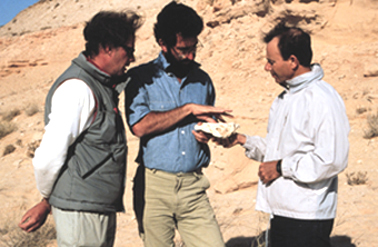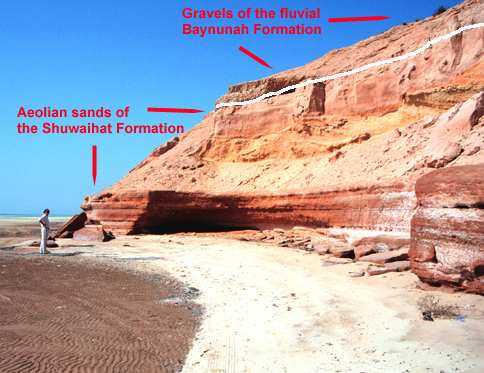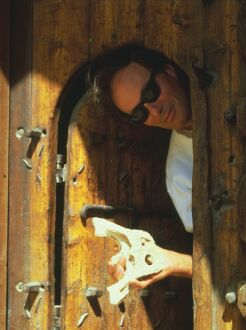[ Obituary
- Press - Research - Photographs
- Publications - Links
- New fossil research ] Discoverer of Abu Dhabi's fossils dies Peter Whybrow, one of the founders of studies of the fossils of the United Arab Emirates, died suddenly on February 13, his family have announced. He was 61. Whybrow first came to south-eastern Arabia in 1979, to carry out fossil research in Qatar, on behalf of what was then the British Museum (Natural History), and later became The Natural History Museum. During that visit, he made a one-day trip across the border into the Emirates, visiting Jebel Barakah, an outcrop on the coast west of Jebel Dhanna. There he found fossil remains of crocodiles and recognised the importance of the rock outcrops in the Western region. On another visit to Jebel Barakah, in 1981, working in collaboration with the Geology Department of the Emirates University, he found more fossils, including teeth of primitive horses, which he dated to the Late Miocene period, from 5 to 11 million years ago. He returned once again in 1984. At the time, another scientist, Professor Andrew Hill, of Yale University, was also studying the fossils of the Western Region, and the two of them came together to plan a joint programme of research. In 1989 and 1990, they worked in association with the Department of Antiquities and Tourism in Al Ain and then, for a further five years, the Whybrow-Hill team carried out further studies with sponsorship from the Abu Dhabi Company for Onshore Oil Operations, ADCO. The results of their work proved to be of international scientific importance. Over an area stretching from Mirfa to Jebel Barakah, covering over 100 kilometres of the UAE coastline, they found numerous fossil sites, with evidence of a wide range of animals, including early elephants, hippopotami, horses, gazelles, crocodiles, turtles and other species. These were eventually dated to around 6-8 million years ago. Whybrow also co-ordinated studies of the fossils to be found in the mountains of the eastern UAE, and carried out surveys in Fujairah. The results of their work, and that of other colleagues, in western Abu Dhabi were the focus of the First International Conference on the Fossil Vertebrates of Arabia, held at Jebel Dhanna in 1995, under the sponsorship of the Minister of Higher Education and Scientific Research, Sheikh Nahyan bin Mubarak Al Nahyan, and with the support of ADCO, this later giving rise to the major book 'Fossil Vertebrates of Arabia,' in 1999. In the process of this research, Whybrow played a major role, not only in co-ordinating and taking part in fieldwork, but also in the associated publication programme. It was Whybrow, for example, who named and dated the two major rock formations from the Late Miocene in Western Abu Dhabi, the Shuweihat Formation and the later Baynunah Formation, around 6-8 million years old, in which the fossils were found. Largely as a result of Whybrow's work, Abu Dhabi became well-known internationally as one of the key areas in the world for fossils of the Miocene period. Whybrow spent most of his working life as a research scientist in the Palaeontology Department of the Natural History Museum in London, carrying out fieldwork not only in the UAE and Qatar, but also in Saudi Arabia, Yemen and Pakistan, as well as in Europe. He retired early in 2002, moving to Cornwall in south-west England, with his wife and two young sons. Ill-health, sadly, prevented him from returning to the UAE, to take part in the continuing studies of Abu Dhabi's fossils being undertaken, with his encouragement, by the Abu Dhabi Islands Archaeological Survey. Instead, he became a keen amateur gardener, and it was, perhaps appropriately, in his garden that he died last Friday of a heart attack, surrounded by the plants that he loved.
Press stories 16
February 2004 Al
Bayan For more information about Peter Whybrow's research on Late Miocene fossils in Abu Dhabi visit: Miocene
Vertebrates from the Emirate of Abu Dhabi, United Arab Emirates - Some photographs of Peter
Whybrow working in Abu Dhabi: Publications by Peter
Whybrow relating to the Late Miocene fossils of Abu Dhabi: Adams, C. G., Gentry, A. W., and Whybrow, P. J. 1983. Dating the terminal Tethyan events. In, Reconstruction of Marine Environments, pp. 30: 273-298 (ed. J. Meulenkamp). Utrecht Micropaleontological Bulletins. As-Saruri, M. L., Whybrow, P. J., and Collinson, M. E. 1999. Vertebrates (?Sirenia), fruits and seeds from the Kaninah Formation (Middle Eocene), Republic of Yemen. In, Fossil Vertebrates of Arabia, pp. 443-453 (ed. P. J. Whybrow and A. Hill). Yale University Press, New Haven. Bruijn, H. de, and Whybrow, P. J. 1994. A Late Miocene rodent fauna from the Baynunah Formation, Emirate of Abu Dhabi, United Arab Emirates. Proceedings Koninklijke Nederlandse Akademie van Wetenschappen, Series B 97:407-422. Eisenmann, V., and Whybrow, P. J. 1999. The hipparions from the Late Miocene Baynunah Formation, Emirate of Abu Dhabi, United Arab Emirates. In, Fossil Vertebrates of Arabia, pp. 234-253 (ed. P. J. Whybrow and A. Hill). Yale University Press, New Haven. Hailwood, E. A., and Whybrow, P. J. 1999. Palaeomagnetic correlation and dating of the Baynunah and Shuwaihat Formations, Emirate of Abu Dhabi, United Arab Emirates. In, Fossil Vertebrates of Arabia, pp. 75-87 (ed. P. J. Whybrow and A. Hill). Yale University Press, New Haven. Hamilton, W. R., Whybrow, P. J., and McClure, H. A. 1978. Fauna of fossil mammals from the Miocene of Saudi Arabia. Nature 274: 248-249. Hill, A., and Whybrow, P. J. 1999. Arabian fossil vertebrates: a summary and overview of the Baynunah fauna and its context. In, Fossil Vertebrates of Arabia, pp. 7-14 (ed. P. J. Whybrow and A. Hill). Yale University Press, New Haven. Hill, A., Whybrow, P. J., and Yasin, W. 1999. History of palaeontological research in the Western Region of the Emirate of Abu Dhabi, United Arab Emirates. In, Fossil Vertebrates of Arabia, pp. 15-23 (ed. P. J. Whybrow and A. Hill). Yale University Press, New Haven. Madden, C. T., Glennie, K. W., Dehm, R., Whitmore, F. C., Schmidt, R. J., Ferfoglia, R. J., and Whybrow, P. J. 1982. Stegotetrabelodon (Proboscidea, Gomphotheriidae) from the Miocene of Abu Dhabi. United States Geological Survey, Jiddah. Whybrow, P. J. 1984. Geological and faunal evidence from Arabia for mammal "migrations" between Asia and Africa during the Miocene. Courier Forschungsinstitüt Senckenberg 69:189-198. ---. 1987a. Miocene geology and palaeontology of Ad Dabtiyah, Saudi Arabia. Bulletin of the British Museum (Natural History), Geology. 41:367-457. ---. 1987b. Miocene geology and palaeontology of the United Arab Emirates and the State of Qatar (Arabian Gulf): the closure of Tethys and mammal `migrations' between Afroarabia and Eurasia. M.Phil Thesis. Reading University, Reading. 136 pp. ---. 1989. New stratotype; the Baynunah Formation (Late Miocene), United Arab Emirates: Lithology and palaeontology. Newsletters on Stratigraphy 21:1-9. ---. 1992a. Land movements and species dispersal. In, The Cambridge Encyclopedia of Human Evolution, pp. 169-173 (ed. S. Jones, R. Martin, and D. Pilbeam). Cambridge University Press, Cambridge. ---. 1992b. Palaeontological and geological studies in the Western and Eastern Regions of Abu Dhabi. Tribulus 2:20. ---. 1992c. Palaeontological and geological study on the Miocene rocks of the Western Region, Emirate of Abu Dhabi, Report to the Abu Dhabi Company for Onshore Oil Operations. The Natural History Museum, London, 51 pp. ---. 1994. Palaeontological and geological study on the Miocene rocks of the Western Region, and a preliminary study on the Eocene-Oligocene rocks near Al Ain, Emirate of Abu Dhabi. Part I General Report, 3rd Report to the Abu Dhabi Company for Onshore Oil Operations. The Natural History Museum, London. 73 pp. --- 1995. Palaeontological
and geological study on Miocene rocks of the Western Region and the
Cretaceous rocks of the Eastern Region, Emirate of Abu Dhabi. Report
on the First International Conference on the Fossil Vertebrates of Arabia,Jebel
Dhanna, March 1995. The Natural History Museum, London.
--- 2000. Travels with the
Fossil Hunters. The Natural History Museum, London. ISBN: 0 521 66301
6. Price: £20.00. Format: Hardback - Size: 247 x 174 mm - Extent:
240 pp, 103 colour plates - Published: March 2000. For more details
about this book click
here. Click on order
to purchase this book via Amazon. Whybrow, P. J., and Bassiouni, M. A. 1986. The Arabian Miocene; rocks, fossils, primates and problems. In, Primate Evolution, pp. 85-91 (ed. J. G. Else and P. C. Lee). Cambridge University Press, Cambridge. Whybrow, P. J., and Clements, D. 1999a. Arabian Tertiary fauna, flora and localities. In, Fossil Vertebrates of Arabia, pp. 460-473 (ed. P. J. Whybrow and A. Hill). Yale University Press, New Haven. ---. 1999b. Late Miocene Baynunah Formation, Emirate of Abu Dhabi, United Arab Emirates; fauna, flora and localities. In, Fossil Vertebrates of Arabia, pp. 317-333 (ed. P. J. Whybrow and A. Hill). Yale University Press, New Haven. Whybrow, P. J., Collinson, M. E., Daams, R., Gentry, A. W., and McClure, H. A. 1982. Geology, fauna (Bovidae, Rodentia) and flora from the Early Miocene of eastern Saudi Arabia. Tertiary Research 4: 105-120. Whybrow, P. J., Friend, P. F., Ditchfield, P. W., and Bristow, C. S. 1999. Local stratigraphy of the Neogene outcrops of the coastal area: Western Region, Emirate of Abu Dhabi, United Arab Emirates. In, Fossil Vertebrates of Arabia, pp. 28-37 (ed. P. J. Whybrow and A. Hill). Yale University Press, New Haven. Whybrow, P. J., and Hill, A. 1995. Report submitted to His Excellency Sheikh Nahayan bin Mubarak al Nahayan on the First International Conference on the Fossil Vertebrates of Arabia, March, 1995. The Natural History Museum, London.
Whybrow, P.J., Hill, A.,
and Kingston, J.D. (1999) Late Miocene fauna and environments of the
Baynunah Formation: Emirate of Abu Dhabi (Western Region), United Arab
Emirates. Journal of the Faculty of Science: U.A.E. University, 10(1):120-145. Whybrow, P. J., Hill, A., Yasin al-Tikriti, W., and Hailwood, E. A. 1990. Late Miocene primate fauna, flora and initial palaeomagnetic data from the Emirate of Abu Dhabi, United Arab Emirates. Journal of Human Evolution 19: 583-588. Whybrow, P. J. ed, Jeffery, P., Gentry, A. W., Andrews, P., Rosen, B. R., Adams, C. G., de Broin, F. de L., van Dijk, P. P., Eisenmann, V., and de Bruijn, H. 1994. Palaeontological and geological study on the Miocene rocks of the Western Region, and a preliminary study on the Eocene-Oligocene rocks near Al Ain, Emirate of Abu Dhabi. Part II Technical Reports, 3rd Report to the Abu Dhabi Company for Onshore Oil Operations. The Natural History Museum, London. 73 pp. Whybrow, P. J., and McClure, H. A. 1981. Fossil mangrove roots and palaeoenvironments of the Miocene of the eastern Arabian peninsula. Palaeogeography, Palaeoclimatology, Palaeoecology 32: 213-225. Whybrow, P. J., McClure,
H. A., and Elliott, G. F. 1987. Miocene stratigraphy, geology, and flora
(algae) of eastern Saudi Arabia and the Ad Dabtiyah vertebrate locality.
In, Miocene geology and palaeontology of Ad Dabtiyah, Saudi Arabia,
(ed. P. J. Whybrow). Links to Peter Whybrow's
work: Paleontological
Reconnaisance In Yemen by Ian Tattersall, James M. Clark and Peter
Whybrow - Yemen Update 37 (1995): 21-24 - online article about his work
in Yemen in 1991. For information about the continued work on Late Miocene fossils being carried out by the Abu Dhabi Islands Archaeological Survey (ADIAS), see: Mleisa
- ADIAS Guide - read about the fossil elephant footprints found
at this remarkable site by ADIAS. Conservation of the elephant tusk found at Ruwais - read about Nigel Larkin's work on the conservation and preparation for display of the 2.54 metre long tusk (February 2003). Conserving more Miocene fossils for the Abu Dhabi Islands Archaeological Survey - read about Nigel Larkin's work on the conservation of further fossil specimens from the Ruwais site (October 2003) Stegotetrabelodon
syrticus - take a look at a series of pictures and film showing
how a scale model is being built of the 6-8 million year old proboscid
found in the Abu Dhabi Late Miocene deposits. This is being built by
Abdul Hafeez from the Taxidermy Unit in the Private Department of His
Highness Sheikh Zayed bin Sultan Al Nahyan. Webpage constructed by Dr Mark Beech, ADIAS - last updated 20 February 2004. |






